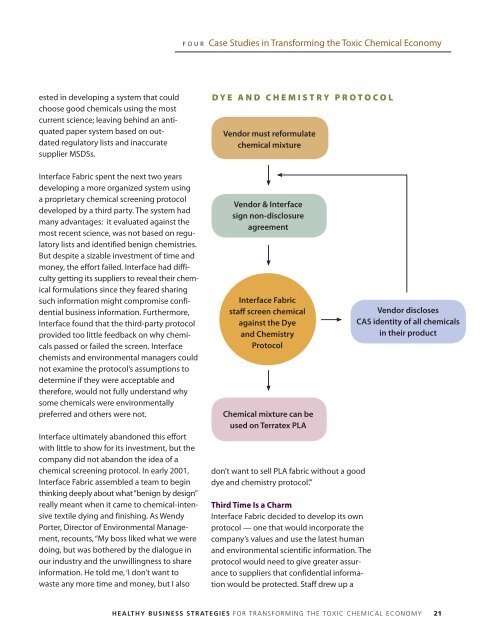Healthy Business Strategies - Clean Production Action
Healthy Business Strategies - Clean Production Action
Healthy Business Strategies - Clean Production Action
Create successful ePaper yourself
Turn your PDF publications into a flip-book with our unique Google optimized e-Paper software.
ested in developing a system that could<br />
choose good chemicals using the most<br />
current science; leaving behind an antiquated<br />
paper system based on out-<br />
dated regulatory lists and inaccurate<br />
supplier MSDSs.<br />
Interface Fabric spent the next two years<br />
developing a more organized system using<br />
a proprietary chemical screening protocol<br />
developed by a third party. The system had<br />
many advantages: it evaluated against the<br />
most recent science, was not based on regulatory<br />
lists and identified benign chemistries.<br />
But despite a sizable investment of time and<br />
money, the effort failed. Interface had difficulty<br />
getting its suppliers to reveal their chemical<br />
formulations since they feared sharing<br />
such information might compromise confidential<br />
business information. Furthermore,<br />
Interface found that the third-party protocol<br />
provided too little feedback on why chemicals<br />
passed or failed the screen. Interface<br />
chemists and environmental managers could<br />
not examine the protocol’s assumptions to<br />
determine if they were acceptable and<br />
therefore, would not fully understand why<br />
some chemicals were environmentally<br />
preferred and others were not.<br />
Interface ultimately abandoned this effort<br />
with little to show for its investment, but the<br />
company did not abandon the idea of a<br />
chemical screening protocol. In early 2001,<br />
Interface Fabric assembled a team to begin<br />
thinking deeply about what “benign by design”<br />
really meant when it came to chemical-intensive<br />
textile dying and finishing. As Wendy<br />
Porter, Director of Environmental Management,<br />
recounts, “My boss liked what we were<br />
doing, but was bothered by the dialogue in<br />
our industry and the unwillingness to share<br />
information. He told me, ‘I don’t want to<br />
waste any more time and money, but I also<br />
F O u R Case Studies in Transforming the Toxic Chemical Economy<br />
D y e A n D C H e m I S t r y P r o t o C o l<br />
Vendor must reformulate<br />
chemical mixture<br />
Vendor & Interface<br />
sign non-disclosure<br />
agreement<br />
Interface Fabric<br />
staff screen chemical<br />
against the Dye<br />
and Chemistry<br />
Protocol<br />
Chemical mixture can be<br />
used on Terratex PLA<br />
don’t want to sell PLA fabric without a good<br />
dye and chemistry protocol’.”<br />
Third Time Is a charm<br />
Interface Fabric decided to develop its own<br />
protocol — one that would incorporate the<br />
company’s values and use the latest human<br />
and environmental scientific information. The<br />
protocol would need to give greater assurance<br />
to suppliers that confidential information<br />
would be protected. Staff drew up a<br />
Vendor discloses<br />
CAS identity of all chemicals<br />
in their product<br />
healthy business strategies for transforming the toxic chemical economy


